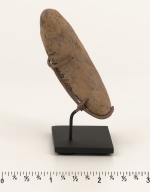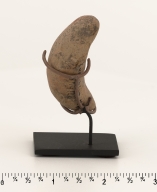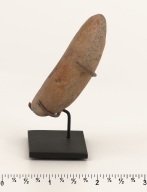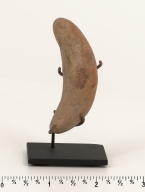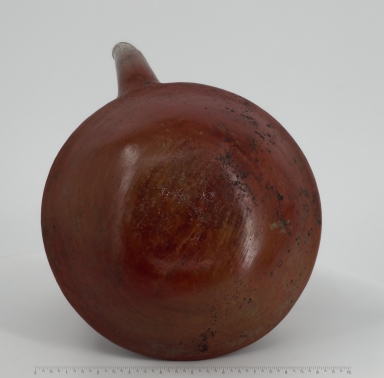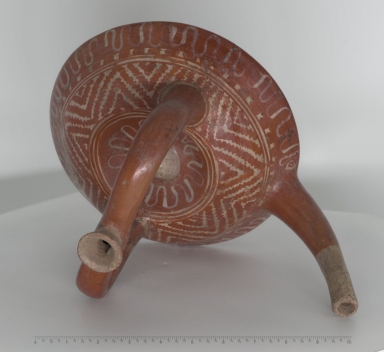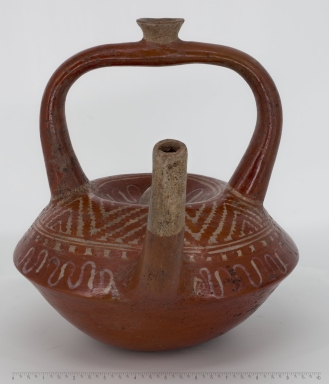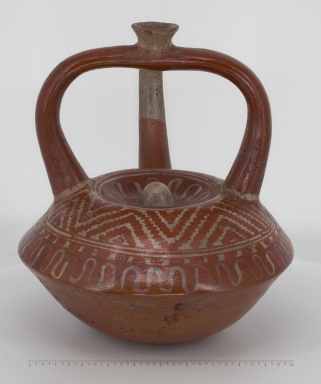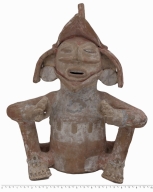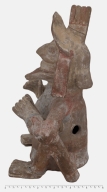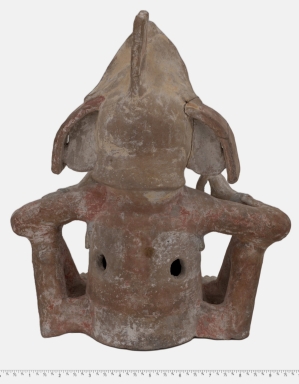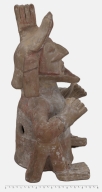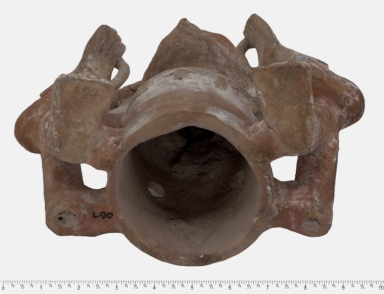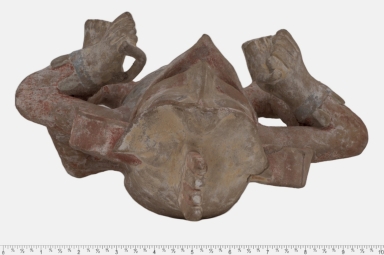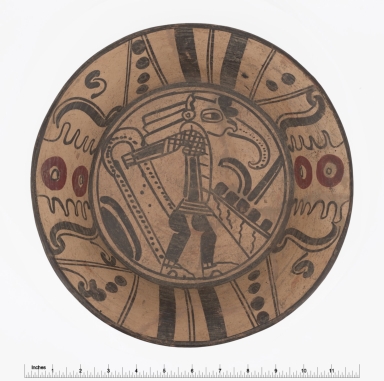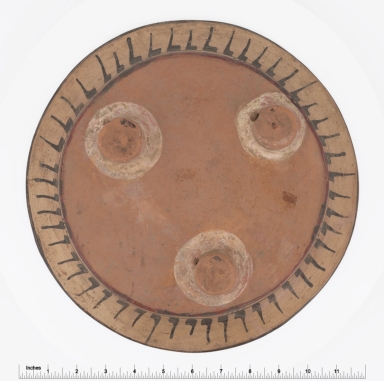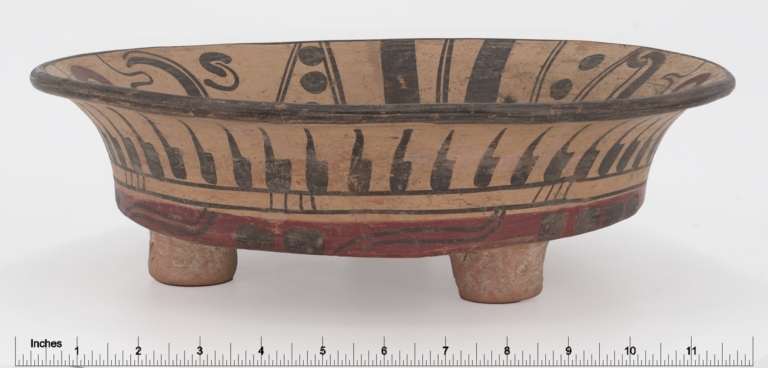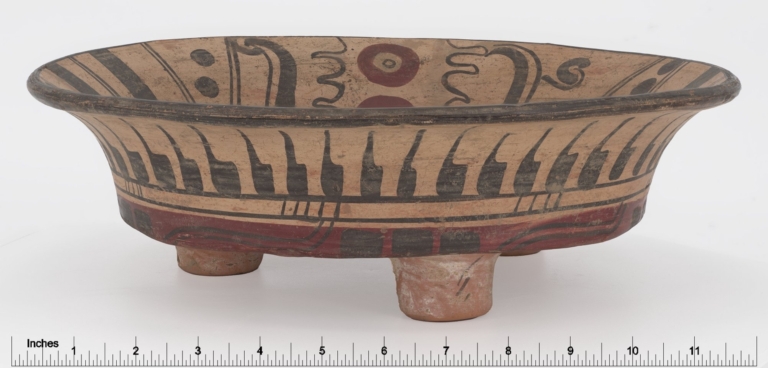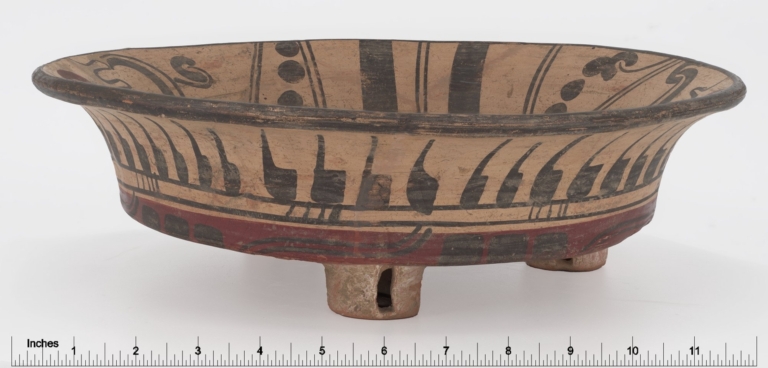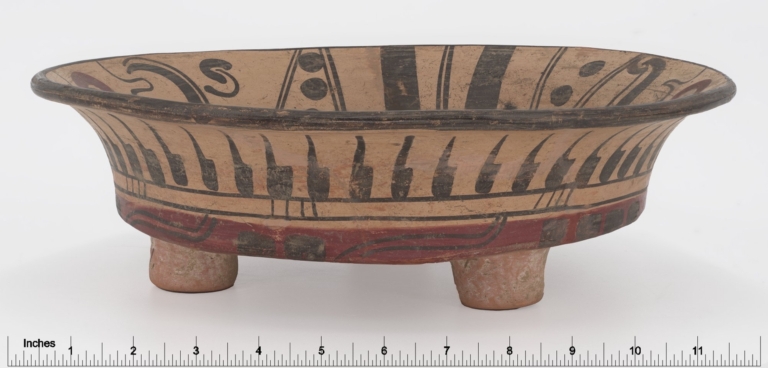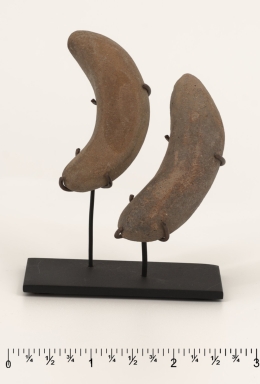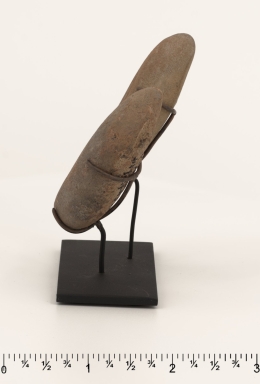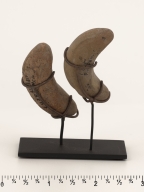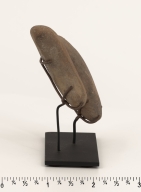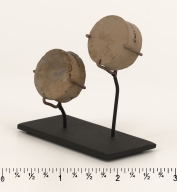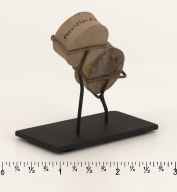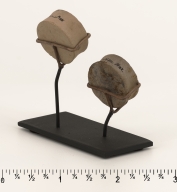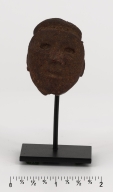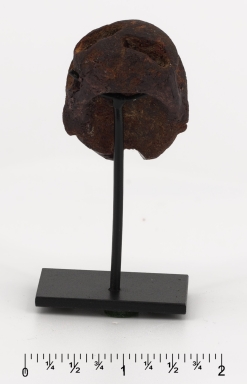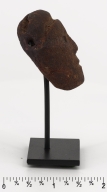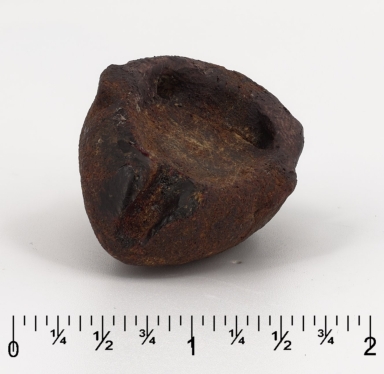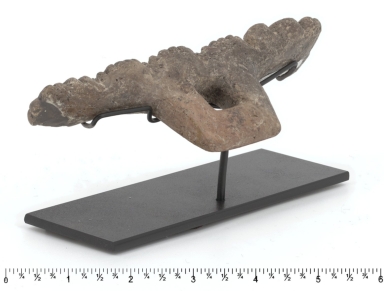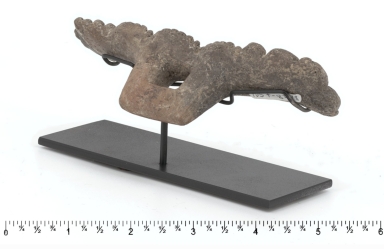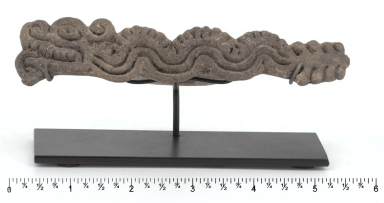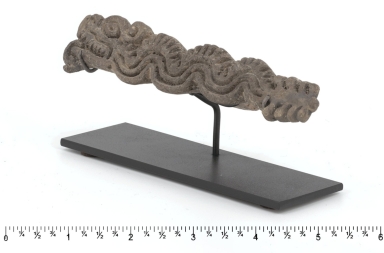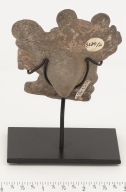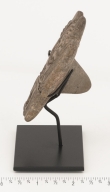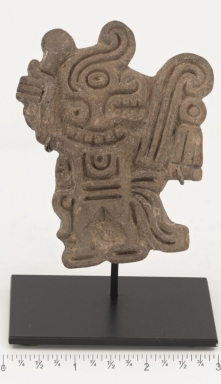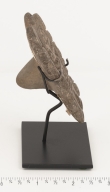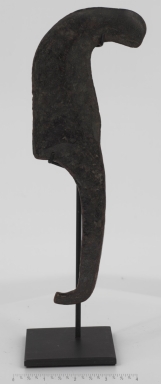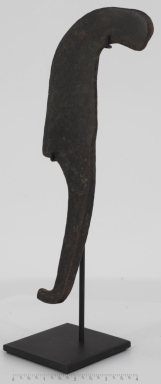|
Title
Huastec ear plug : banana form.
Subject
[Ceramic jewelry--Mexico--Cuautitlán River Valley, Decoration and ornament--Mexico--Cuautitlán River Valley, Art--Mexico--Cuautitlán River Valley, Indigenous peoples--Antiquities]
Date
between 1200 and 1521
Title
Huastec ear plug : banana form.
Subject
[Ceramic jewelry--Mexico--Cuautitlán River Valley, Decoration and ornament--Mexico--Cuautitlán River Valley, Art--Mexico--Cuautitlán River Valley, Indigenous peoples--Antiquities]
Date
between 1200 and 1521
Title
Huastec ear plug : banana form.
Subject
[Ceramic jewelry--Mexico--Cuautitlán River Valley, Decoration and ornament--Mexico--Cuautitlán River Valley, Art--Mexico--Cuautitlán River Valley, Indigenous peoples--Antiquities]
Date
between 1200 and 1521
Title
Huastec ear plug : banana form.
Subject
[Ceramic jewelry--Mexico--Cuautitlán River Valley, Decoration and ornament--Mexico--Cuautitlán River Valley, Art--Mexico--Cuautitlán River Valley, Indigenous peoples--Antiquities]
Date
between 1200 and 1521
Title
Huastec ear plug : banana form.
Subject
[Ceramic jewelry--Mexico--Cuautitlán River Valley, Decoration and ornament--Mexico--Cuautitlán River Valley, Art--Mexico--Cuautitlán River Valley, Indigenous peoples--Antiquities]
Date
between 1200 and 1521
Title
Tzintzuntzan teapot with stirrup handle.
Description
This unique serving vessel, in the form of a teapot or ewer, features a funnel opening, a stirrup handle, and a curved spout. The center of the vessel has a depressed top with a protruding button. The artist used a resist slip process to create the white slip design on red slip ground.
Subject
[Ceramic teapots--Mexico--Michoacán de Ocampo, Pottery--Mexico--Michoacán de Ocampo, Art--Mexico--Michoacán de Ocampo, Indigenous peoples--Antiquities]
Date
between 1200 and 1521
Title
Tzintzuntzan teapot with stirrup handle.
Description
This unique serving vessel, in the form of a teapot or ewer, features a funnel opening, a stirrup handle, and a curved spout. The center of the vessel has a depressed top with a protruding button. The artist used a resist slip process to create the white slip design on red slip ground.
Subject
[Ceramic teapots--Mexico--Michoacán de Ocampo, Pottery--Mexico--Michoacán de Ocampo, Art--Mexico--Michoacán de Ocampo, Indigenous peoples--Antiquities]
Date
between 1200 and 1521
Title
Tzintzuntzan teapot with stirrup handle.
Description
This unique serving vessel, in the form of a teapot or ewer, features a funnel opening, a stirrup handle, and a curved spout. The center of the vessel has a depressed top with a protruding button. The artist used a resist slip process to create the white slip design on red slip ground.
Subject
[Ceramic teapots--Mexico--Michoacán de Ocampo, Pottery--Mexico--Michoacán de Ocampo, Art--Mexico--Michoacán de Ocampo, Indigenous peoples--Antiquities]
Date
between 1200 and 1521
Title
Tzintzuntzan teapot with stirrup handle.
Description
This unique serving vessel, in the form of a teapot or ewer, features a funnel opening, a stirrup handle, and a curved spout. The center of the vessel has a depressed top with a protruding button. The artist used a resist slip process to create the white slip design on red slip ground.
Subject
[Ceramic teapots--Mexico--Michoacán de Ocampo, Pottery--Mexico--Michoacán de Ocampo, Art--Mexico--Michoacán de Ocampo, Indigenous peoples--Antiquities]
Date
between 1200 and 1521
Title
Tzintzuntzan teapot with stirrup handle.
Description
This unique serving vessel, in the form of a teapot or ewer, features a funnel opening, a stirrup handle, and a curved spout. The center of the vessel has a depressed top with a protruding button. The artist used a resist slip process to create the white slip design on red slip ground.
Subject
[Ceramic teapots--Mexico--Michoacán de Ocampo, Pottery--Mexico--Michoacán de Ocampo, Art--Mexico--Michoacán de Ocampo, Indigenous peoples--Antiquities]
Date
between 1200 and 1521
Title
Tzintzuntzan teapot with stirrup handle.
Description
This unique serving vessel, in the form of a teapot or ewer, features a funnel opening, a stirrup handle, and a curved spout. The center of the vessel has a depressed top with a protruding button. The artist used a resist slip process to create the white slip design on red slip ground.
Subject
[Ceramic teapots--Mexico--Michoacán de Ocampo, Pottery--Mexico--Michoacán de Ocampo, Art--Mexico--Michoacán de Ocampo, Indigenous peoples--Antiquities]
Date
between 1200 and 1521
Title
Anthropomorphic xantil : cult image : incense burner.
Description
Burning Copal incense in the body of the Xantil produced a dense sweet smoke which emerges from his mouth. Xochipilli-Macuilxochitl, the young solar diety of sensuality, will appear to be chanting or singing. The god wears a bird-hed helmet with a crest, a long nose bar, a pair of round ear ornaments, a white collar, bracelets and knotted sandals.
Subject
[Ceramic sculpture--Mexico--Oaxaca (State), Mixtec art--Mexico--Oaxaca (State), Indigenous Peoples--Antiquities]
Date
between 1200 and 1521
Title
Anthropomorphic xantil : cult image : incense burner.
Description
Burning Copal incense in the body of the Xantil produced a dense sweet smoke which emerges from his mouth. Xochipilli-Macuilxochitl, the young solar diety of sensuality, will appear to be chanting or singing. The god wears a bird-hed helmet with a crest, a long nose bar, a pair of round ear ornaments, a white collar, bracelets and knotted sandals.
Subject
[Ceramic sculpture--Mexico--Oaxaca (State), Mixtec art--Mexico--Oaxaca (State), Indigenous Peoples--Antiquities]
Date
between 1200 and 1521
Title
Anthropomorphic xantil : cult image : incense burner.
Description
Burning Copal incense in the body of the Xantil produced a dense sweet smoke which emerges from his mouth. Xochipilli-Macuilxochitl, the young solar diety of sensuality, will appear to be chanting or singing. The god wears a bird-hed helmet with a crest, a long nose bar, a pair of round ear ornaments, a white collar, bracelets and knotted sandals.
Subject
[Ceramic sculpture--Mexico--Oaxaca (State), Mixtec art--Mexico--Oaxaca (State), Indigenous Peoples--Antiquities]
Date
between 1200 and 1521
Title
Anthropomorphic xantil : cult image : incense burner.
Description
Burning Copal incense in the body of the Xantil produced a dense sweet smoke which emerges from his mouth. Xochipilli-Macuilxochitl, the young solar diety of sensuality, will appear to be chanting or singing. The god wears a bird-hed helmet with a crest, a long nose bar, a pair of round ear ornaments, a white collar, bracelets and knotted sandals.
Subject
[Ceramic sculpture--Mexico--Oaxaca (State), Mixtec art--Mexico--Oaxaca (State), Indigenous Peoples--Antiquities]
Date
between 1200 and 1521
Title
Anthropomorphic xantil : cult image : incense burner.
Description
Burning Copal incense in the body of the Xantil produced a dense sweet smoke which emerges from his mouth. Xochipilli-Macuilxochitl, the young solar diety of sensuality, will appear to be chanting or singing. The god wears a bird-hed helmet with a crest, a long nose bar, a pair of round ear ornaments, a white collar, bracelets and knotted sandals.
Subject
[Ceramic sculpture--Mexico--Oaxaca (State), Mixtec art--Mexico--Oaxaca (State), Indigenous Peoples--Antiquities]
Date
between 1200 and 1521
Title
Anthropomorphic xantil : cult image : incense burner.
Description
Burning Copal incense in the body of the Xantil produced a dense sweet smoke which emerges from his mouth. Xochipilli-Macuilxochitl, the young solar diety of sensuality, will appear to be chanting or singing. The god wears a bird-hed helmet with a crest, a long nose bar, a pair of round ear ornaments, a white collar, bracelets and knotted sandals.
Subject
[Ceramic sculpture--Mexico--Oaxaca (State), Mixtec art--Mexico--Oaxaca (State), Indigenous Peoples--Antiquities]
Date
between 1200 and 1521
Title
Tripodal plate with a flat bottom and flaring side.
Description
The tripodal plate is in good condition. The inside of the legs rattle and each leg have rectangular openings on the side there is also some white pigment in circular form on the base of the legs. The plate is made of ceramic and buff clay with cream slip decorated with red, red- brown, and black pigments. There is a noticeable crack on the outside rim of the plate. The overall pigment of the plate is fading.
Subject
[Plates (Tableware)--Mexico--Sacrificios Island, Ceramic tableware--Mexico--Sacrificios Island, Art--Mexico--Sacrificios Island, Indigenous peoples--Antiquities]
Date
between 1200 and 1521
Title
Tripodal plate with a flat bottom and flaring side.
Description
The tripodal plate is in good condition. The inside of the legs rattle and each leg have rectangular openings on the side there is also some white pigment in circular form on the base of the legs. The plate is made of ceramic and buff clay with cream slip decorated with red, red- brown, and black pigments. There is a noticeable crack on the outside rim of the plate. The overall pigment of the plate is fading.
Subject
[Plates (Tableware)--Mexico--Sacrificios Island, Ceramic tableware--Mexico--Sacrificios Island, Art--Mexico--Sacrificios Island, Indigenous peoples--Antiquities]
Date
between 1200 and 1521
Title
Tripodal plate with a flat bottom and flaring side.
Description
The tripodal plate is in good condition. The inside of the legs rattle and each leg have rectangular openings on the side there is also some white pigment in circular form on the base of the legs. The plate is made of ceramic and buff clay with cream slip decorated with red, red- brown, and black pigments. There is a noticeable crack on the outside rim of the plate. The overall pigment of the plate is fading.
Subject
[Plates (Tableware)--Mexico--Sacrificios Island, Ceramic tableware--Mexico--Sacrificios Island, Art--Mexico--Sacrificios Island, Indigenous peoples--Antiquities]
Date
between 1200 and 1521
Title
Tripodal plate with a flat bottom and flaring side.
Description
The tripodal plate is in good condition. The inside of the legs rattle and each leg have rectangular openings on the side there is also some white pigment in circular form on the base of the legs. The plate is made of ceramic and buff clay with cream slip decorated with red, red- brown, and black pigments. There is a noticeable crack on the outside rim of the plate. The overall pigment of the plate is fading.
Subject
[Plates (Tableware)--Mexico--Sacrificios Island, Ceramic tableware--Mexico--Sacrificios Island, Art--Mexico--Sacrificios Island, Indigenous peoples--Antiquities]
Date
between 1200 and 1521
Title
Tripodal plate with a flat bottom and flaring side.
Description
The tripodal plate is in good condition. The inside of the legs rattle and each leg have rectangular openings on the side there is also some white pigment in circular form on the base of the legs. The plate is made of ceramic and buff clay with cream slip decorated with red, red- brown, and black pigments. There is a noticeable crack on the outside rim of the plate. The overall pigment of the plate is fading.
Subject
[Plates (Tableware)--Mexico--Sacrificios Island, Ceramic tableware--Mexico--Sacrificios Island, Art--Mexico--Sacrificios Island, Indigenous peoples--Antiquities]
Date
between 1200 and 1521
Title
Tripodal plate with a flat bottom and flaring side.
Description
The tripodal plate is in good condition. The inside of the legs rattle and each leg have rectangular openings on the side there is also some white pigment in circular form on the base of the legs. The plate is made of ceramic and buff clay with cream slip decorated with red, red- brown, and black pigments. There is a noticeable crack on the outside rim of the plate. The overall pigment of the plate is fading.
Subject
[Plates (Tableware)--Mexico--Sacrificios Island, Ceramic tableware--Mexico--Sacrificios Island, Art--Mexico--Sacrificios Island, Indigenous peoples--Antiquities]
Date
between 1200 and 1521
Title
Aztec, Mexica ear plugs : banana form.
Description
This non-matching pair of plugs represent a different style of body adornment used by the non-elite. They came in different sizes and shapes suitable to the wearer. The banana plug was worn by the Aztec and the Gulf Coast Huastec. It is possible they could be nose ornaments or ear plugs.
Subject
[Decoration and ornament--Mexico, Ceramic jewelry--Mexico, Aztec art--Mexico, Indigenous peoples--Antiquities]
Date
between 1200 and 1521
Title
Aztec, Mexica ear plugs : banana form.
Description
This non-matching pair of plugs represent a different style of body adornment used by the non-elite. They came in different sizes and shapes suitable to the wearer. The banana plug was worn by the Aztec and the Gulf Coast Huastec. It is possible they could be nose ornaments or ear plugs.
Subject
[Decoration and ornament--Mexico, Ceramic jewelry--Mexico, Aztec art--Mexico, Indigenous peoples--Antiquities]
Date
between 1200 and 1521
Title
Aztec, Mexica ear plugs : banana form.
Description
This non-matching pair of plugs represent a different style of body adornment used by the non-elite. They came in different sizes and shapes suitable to the wearer. The banana plug was worn by the Aztec and the Gulf Coast Huastec. It is possible they could be nose ornaments or ear plugs.
Subject
[Decoration and ornament--Mexico, Ceramic jewelry--Mexico, Aztec art--Mexico, Indigenous peoples--Antiquities]
Date
between 1200 and 1521
Title
Aztec, Mexica ear plugs : banana form.
Description
This non-matching pair of plugs represent a different style of body adornment used by the non-elite. They came in different sizes and shapes suitable to the wearer. The banana plug was worn by the Aztec and the Gulf Coast Huastec. It is possible they could be nose ornaments or ear plugs.
Subject
[Decoration and ornament--Mexico, Ceramic jewelry--Mexico, Aztec art--Mexico, Indigenous peoples--Antiquities]
Date
between 1200 and 1521
Title
Aztec ear plugs : disc form.
Description
Mesoamerica people decorated their bodies in various ways. The elite wore articles made of rare materials like cotton, bird feathers, semi-precious gems, and metals. Common man wore objects made of clay, wood, or perishable common materials. These disce ear plugs were won by non-elites. Their curved sides are slightly concave to facilitate wear. They were held in place by force fitting.
Subject
[Ceramic jewelry--Mexico--Cuautitlán River Valley, Decoration and ornament--Mexico--Cuautitlán River Valley, Azetc art--Mexico--Cuautitlán River Valley, Indigenous peoples--Antiquities]
Date
between 1200 and 1521
Title
Aztec ear plugs : disc form.
Description
Mesoamerica people decorated their bodies in various ways. The elite wore articles made of rare materials like cotton, bird feathers, semi-precious gems, and metals. Common man wore objects made of clay, wood, or perishable common materials. These disce ear plugs were won by non-elites. Their curved sides are slightly concave to facilitate wear. They were held in place by force fitting.
Subject
[Ceramic jewelry--Mexico--Cuautitlán River Valley, Decoration and ornament--Mexico--Cuautitlán River Valley, Azetc art--Mexico--Cuautitlán River Valley, Indigenous peoples--Antiquities]
Date
between 1200 and 1521
Title
Aztec ear plugs : disc form.
Description
Mesoamerica people decorated their bodies in various ways. The elite wore articles made of rare materials like cotton, bird feathers, semi-precious gems, and metals. Common man wore objects made of clay, wood, or perishable common materials. These disce ear plugs were won by non-elites. Their curved sides are slightly concave to facilitate wear. They were held in place by force fitting.
Subject
[Ceramic jewelry--Mexico--Cuautitlán River Valley, Decoration and ornament--Mexico--Cuautitlán River Valley, Azetc art--Mexico--Cuautitlán River Valley, Indigenous peoples--Antiquities]
Date
between 1200 and 1521
Title
Aztec ear plugs : disc form.
Description
Mesoamerica people decorated their bodies in various ways. The elite wore articles made of rare materials like cotton, bird feathers, semi-precious gems, and metals. Common man wore objects made of clay, wood, or perishable common materials. These disce ear plugs were won by non-elites. Their curved sides are slightly concave to facilitate wear. They were held in place by force fitting.
Subject
[Ceramic jewelry--Mexico--Cuautitlán River Valley, Decoration and ornament--Mexico--Cuautitlán River Valley, Azetc art--Mexico--Cuautitlán River Valley, Indigenous peoples--Antiquities]
Date
between 1200 and 1521
Title
Aztec carved amber resin head.
Description
Amber, which is fossilized vegetable resin, comes in yellow, reddish-yellow, and brownish-yellow. The resin from evergreen (fir and pine trees) is hard, brittle, transparent/translucent, and amorphous. The source of Mexican amber/Chiapan amber is Mexico, Chiapas, Huitiupan area, Simojovel. The amber head could be from AD 1980. A modern artifact/pendant that was carved, drilled, inlaid, and decorated with colorful hummingbird feathers for tourist trade in San Cristobal, Chiapas, Mexico.
Subject
[Aztec sculpture--Mexico--Chiapas, Sculpture--Mexico--Chiapas, Aztec art--Mexico--Chiapas, Indigenous peoples--Antiquities]
Date
between 1200 and 1521
Title
Aztec carved amber resin head.
Description
Amber, which is fossilized vegetable resin, comes in yellow, reddish-yellow, and brownish-yellow. The resin from evergreen (fir and pine trees) is hard, brittle, transparent/translucent, and amorphous. The source of Mexican amber/Chiapan amber is Mexico, Chiapas, Huitiupan area, Simojovel. The amber head could be from AD 1980. A modern artifact/pendant that was carved, drilled, inlaid, and decorated with colorful hummingbird feathers for tourist trade in San Cristobal, Chiapas, Mexico.
Subject
[Aztec sculpture--Mexico--Chiapas, Sculpture--Mexico--Chiapas, Aztec art--Mexico--Chiapas, Indigenous peoples--Antiquities]
Date
between 1200 and 1521
Title
Aztec carved amber resin head.
Description
Amber, which is fossilized vegetable resin, comes in yellow, reddish-yellow, and brownish-yellow. The resin from evergreen (fir and pine trees) is hard, brittle, transparent/translucent, and amorphous. The source of Mexican amber/Chiapan amber is Mexico, Chiapas, Huitiupan area, Simojovel. The amber head could be from AD 1980. A modern artifact/pendant that was carved, drilled, inlaid, and decorated with colorful hummingbird feathers for tourist trade in San Cristobal, Chiapas, Mexico.
Subject
[Aztec sculpture--Mexico--Chiapas, Sculpture--Mexico--Chiapas, Aztec art--Mexico--Chiapas, Indigenous peoples--Antiquities]
Date
between 1200 and 1521
Title
Aztec carved amber resin head.
Description
Amber, which is fossilized vegetable resin, comes in yellow, reddish-yellow, and brownish-yellow. The resin from evergreen (fir and pine trees) is hard, brittle, transparent/translucent, and amorphous. The source of Mexican amber/Chiapan amber is Mexico, Chiapas, Huitiupan area, Simojovel. The amber head could be from AD 1980. A modern artifact/pendant that was carved, drilled, inlaid, and decorated with colorful hummingbird feathers for tourist trade in San Cristobal, Chiapas, Mexico.
Subject
[Aztec sculpture--Mexico--Chiapas, Sculpture--Mexico--Chiapas, Aztec art--Mexico--Chiapas, Indigenous peoples--Antiquities]
Date
between 1200 and 1521
Title
Aztec carved amber resin head.
Description
Amber, which is fossilized vegetable resin, comes in yellow, reddish-yellow, and brownish-yellow. The resin from evergreen (fir and pine trees) is hard, brittle, transparent/translucent, and amorphous. The source of Mexican amber/Chiapan amber is Mexico, Chiapas, Huitiupan area, Simojovel. The amber head could be from AD 1980. A modern artifact/pendant that was carved, drilled, inlaid, and decorated with colorful hummingbird feathers for tourist trade in San Cristobal, Chiapas, Mexico.
Subject
[Aztec sculpture--Mexico--Chiapas, Sculpture--Mexico--Chiapas, Aztec art--Mexico--Chiapas, Indigenous peoples--Antiquities]
Date
between 1200 and 1521
Title
Aztec body stamp : undulating serpent.
Description
A brownware stamp features a plumed undulating rattlesnake. Post Classic Aztec myth speaks of his forceful breath which caused the newly created sun to move. His name is Ehecatl-Quetzalcoatl, the plumed serpent of wind, rain, and agricultural fertility.
Subject
[Aztec sculpture--Mexico, Ceramic sculpture--Mexico, Aztec art--Mexico, Indigenous peoples--Antiquities]
Date
between 1200 and 1521
Title
Aztec body stamp : undulating serpent.
Description
A brownware stamp features a plumed undulating rattlesnake. Post Classic Aztec myth speaks of his forceful breath which caused the newly created sun to move. His name is Ehecatl-Quetzalcoatl, the plumed serpent of wind, rain, and agricultural fertility.
Subject
[Aztec sculpture--Mexico, Ceramic sculpture--Mexico, Aztec art--Mexico, Indigenous peoples--Antiquities]
Date
between 1200 and 1521
Title
Aztec body stamp : undulating serpent.
Description
A brownware stamp features a plumed undulating rattlesnake. Post Classic Aztec myth speaks of his forceful breath which caused the newly created sun to move. His name is Ehecatl-Quetzalcoatl, the plumed serpent of wind, rain, and agricultural fertility.
Subject
[Aztec sculpture--Mexico, Ceramic sculpture--Mexico, Aztec art--Mexico, Indigenous peoples--Antiquities]
Date
between 1200 and 1521
Title
Aztec body stamp : undulating serpent.
Description
A brownware stamp features a plumed undulating rattlesnake. Post Classic Aztec myth speaks of his forceful breath which caused the newly created sun to move. His name is Ehecatl-Quetzalcoatl, the plumed serpent of wind, rain, and agricultural fertility.
Subject
[Aztec sculpture--Mexico, Ceramic sculpture--Mexico, Aztec art--Mexico, Indigenous peoples--Antiquities]
Date
between 1200 and 1521
Title
Aztec body stamp : undulating serpent.
Description
A brownware stamp features a plumed undulating rattlesnake. Post Classic Aztec myth speaks of his forceful breath which caused the newly created sun to move. His name is Ehecatl-Quetzalcoatl, the plumed serpent of wind, rain, and agricultural fertility.
Subject
[Aztec sculpture--Mexico, Ceramic sculpture--Mexico, Aztec art--Mexico, Indigenous peoples--Antiquities]
Date
between 1200 and 1521
Title
Aztec body stamp : monkey warrior.
Description
This anthropomorphic zoomorphic stamp illustrates a humanized monkey warrior, which carries a mace-like weapon and a shield. On his waist appears a longitudinal cross section of a shell, which can stand for Quetzalcoatl. The monkey image relates to Quetzalcoatl.
Subject
[Aztec sculpture--Mexico, Ceramic sculpture--Mexico, Aztec art--Mexico, Indigenous peoples--Antiquities]
Date
between 1200 and 1521
Title
Aztec body stamp : monkey warrior.
Description
This anthropomorphic zoomorphic stamp illustrates a humanized monkey warrior, which carries a mace-like weapon and a shield. On his waist appears a longitudinal cross section of a shell, which can stand for Quetzalcoatl. The monkey image relates to Quetzalcoatl.
Subject
[Aztec sculpture--Mexico, Ceramic sculpture--Mexico, Aztec art--Mexico, Indigenous peoples--Antiquities]
Date
between 1200 and 1521
Title
Aztec body stamp : monkey warrior.
Description
This anthropomorphic zoomorphic stamp illustrates a humanized monkey warrior, which carries a mace-like weapon and a shield. On his waist appears a longitudinal cross section of a shell, which can stand for Quetzalcoatl. The monkey image relates to Quetzalcoatl.
Subject
[Aztec sculpture--Mexico, Ceramic sculpture--Mexico, Aztec art--Mexico, Indigenous peoples--Antiquities]
Date
between 1200 and 1521
Title
Aztec body stamp : monkey warrior.
Description
This anthropomorphic zoomorphic stamp illustrates a humanized monkey warrior, which carries a mace-like weapon and a shield. On his waist appears a longitudinal cross section of a shell, which can stand for Quetzalcoatl. The monkey image relates to Quetzalcoatl.
Subject
[Aztec sculpture--Mexico, Ceramic sculpture--Mexico, Aztec art--Mexico, Indigenous peoples--Antiquities]
Date
between 1200 and 1521
Title
Purepecha hatchet : sling blade.
Description
The Purepechas or Tarascans are one of the few Mesoamerican cultures to work or forge metal. Copper ore was smelted to form tools and weapons. This bronze sling blade, called an asymmetrical hoe or a Taregue, was used to clear brush or as a digging stick.
Subject
[Weapons--Mexico--Morelia (Michoacán de Ocampo), Purépecha art--Mexico--Morelia (Michoacán de Ocampo), Indigenous peoples--Antiquities]
Date
between 1200 and 1521
Title
Purepecha hatchet : sling blade.
Description
The Purepechas or Tarascans are one of the few Mesoamerican cultures to work or forge metal. Copper ore was smelted to form tools and weapons. This bronze sling blade, called an asymmetrical hoe or a Taregue, was used to clear brush or as a digging stick.
Subject
[Weapons--Mexico--Morelia (Michoacán de Ocampo), Purépecha art--Mexico--Morelia (Michoacán de Ocampo), Indigenous peoples--Antiquities]
Date
between 1200 and 1521
Title
Purepecha hatchet : sling blade.
Description
The Purepechas or Tarascans are one of the few Mesoamerican cultures to work or forge metal. Copper ore was smelted to form tools and weapons. This bronze sling blade, called an asymmetrical hoe or a Taregue, was used to clear brush or as a digging stick.
Subject
[Weapons--Mexico--Morelia (Michoacán de Ocampo), Purépecha art--Mexico--Morelia (Michoacán de Ocampo), Indigenous peoples--Antiquities]
Date
between 1200 and 1521
Title
Purepecha hatchet : sling blade.
Description
The Purepechas or Tarascans are one of the few Mesoamerican cultures to work or forge metal. Copper ore was smelted to form tools and weapons. This bronze sling blade, called an asymmetrical hoe or a Taregue, was used to clear brush or as a digging stick.
Subject
[Weapons--Mexico--Morelia (Michoacán de Ocampo), Purépecha art--Mexico--Morelia (Michoacán de Ocampo), Indigenous peoples--Antiquities]
Date
between 1200 and 1521
Title
Purepecha hatchet : sling blade.
Description
The Purepechas or Tarascans are one of the few Mesoamerican cultures to work or forge metal. Copper ore was smelted to form tools and weapons. This bronze sling blade, called an asymmetrical hoe or a Taregue, was used to clear brush or as a digging stick.
Subject
[Weapons--Mexico--Morelia (Michoacán de Ocampo), Purépecha art--Mexico--Morelia (Michoacán de Ocampo), Indigenous peoples--Antiquities]
Date
between 1200 and 1521
|

